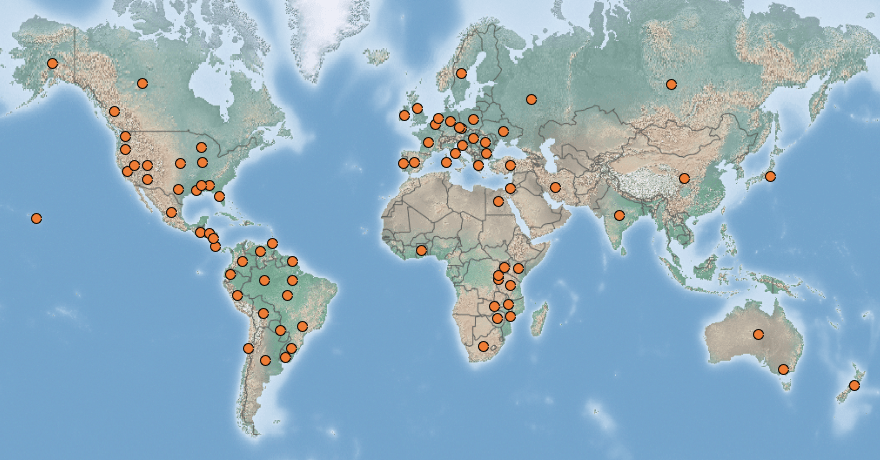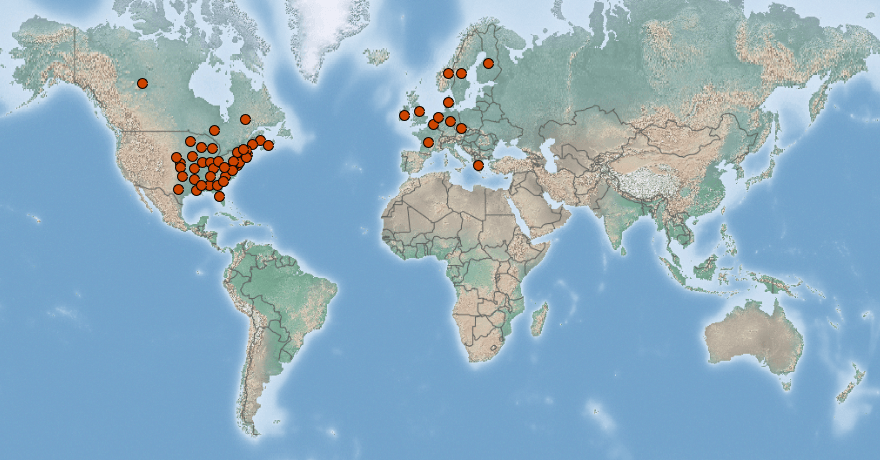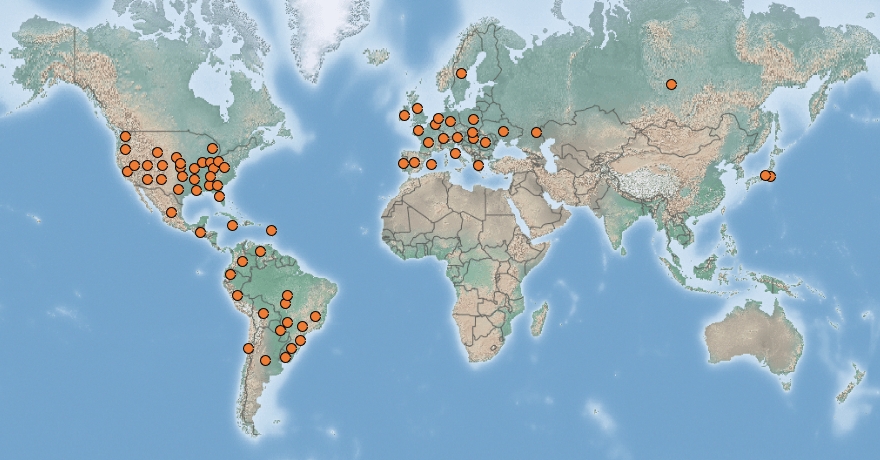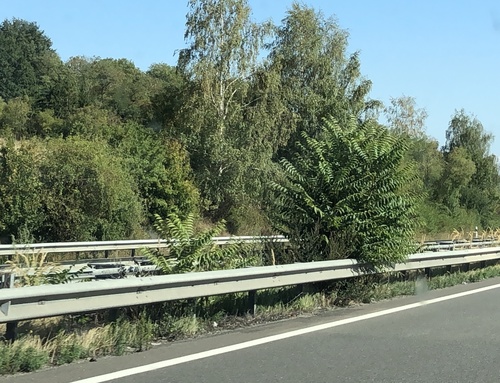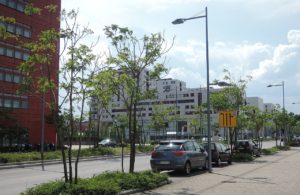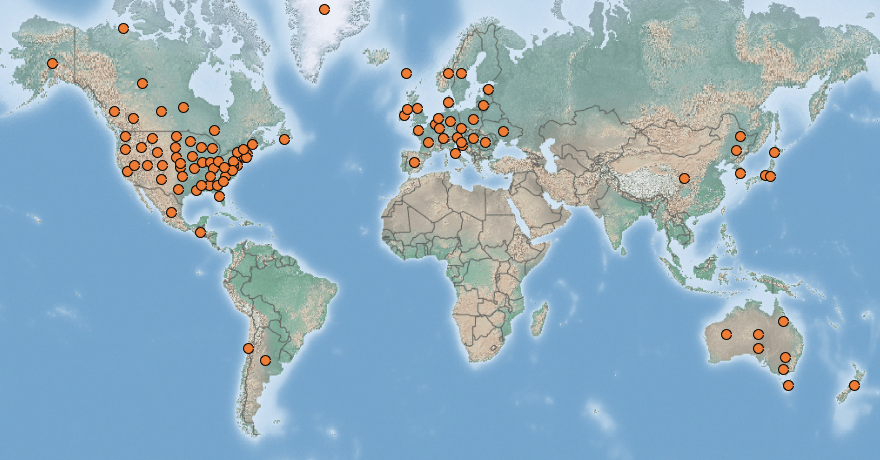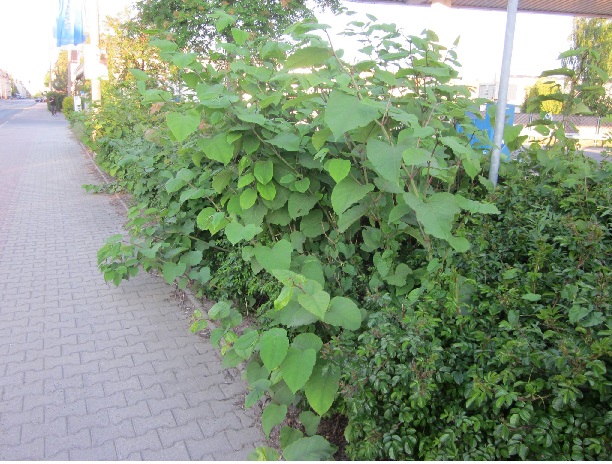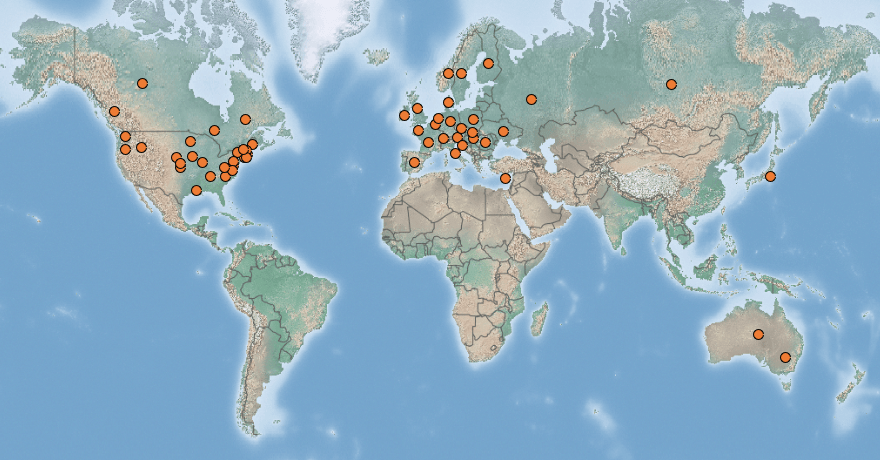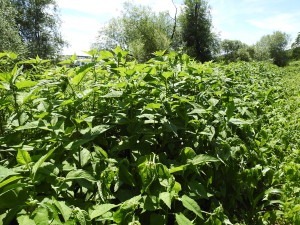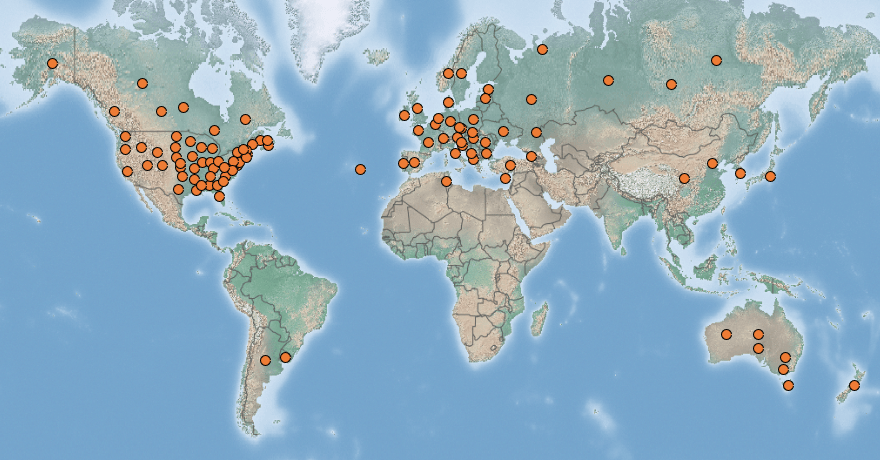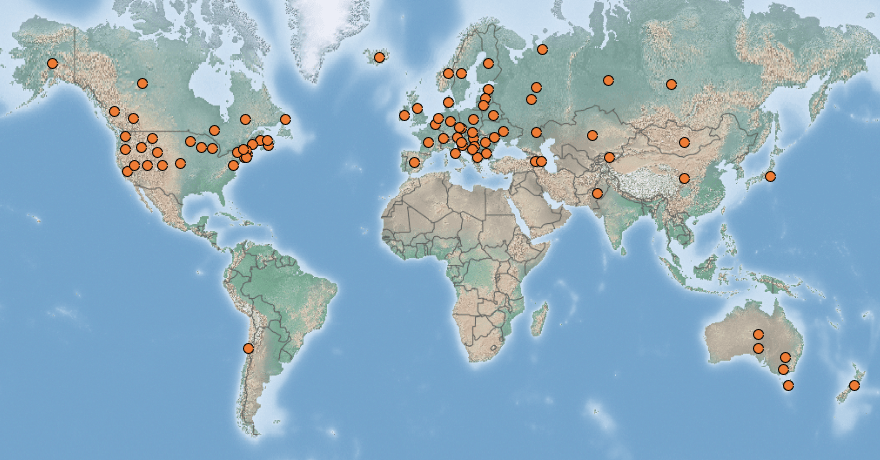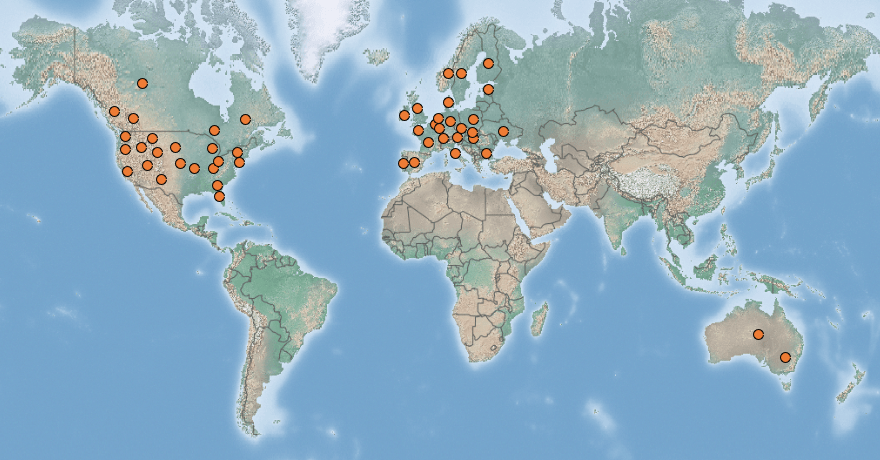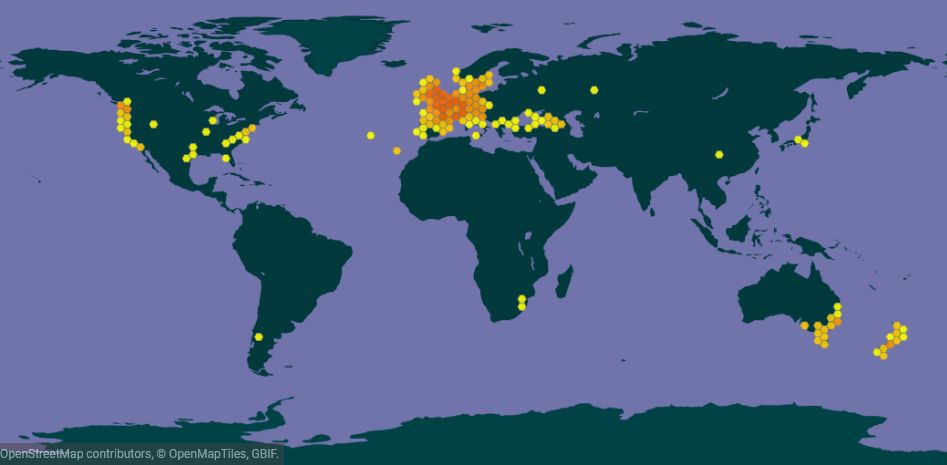 |
Cherry laurel |
Status LU: established. 1st record: LU <1875, ITW 1989. |
 |
Lorber-Kiischtebam |
Status Eur.: established. 1st record: IT ~1550. |
 |
Laurier-cerise |
RA: ISEIA: B3, Watch List. Harmonia+: 0,45. |
 |
Lorbeer-Kirsche |
Wikipedia:     | Wikispecies: | Wikispecies:  |
 |
Laurierkers |
Back to the list of neophytes |
Spot the cherry laurel – citizen science with children
The Department of Ecology of MNHNL carried out a citizen science survey with children who are members of the Panda Club of the Luxembourg National Museum of Natural History (Schaltz 2017). See the post Spot the cherry laurel – A citizen science survey with children for more details.
Brief description

Cherry laurel in a forest near Steinsel. 11/03/2017, Manou Pfeiffenschneider.
Prunus laurocerasus L. is a shrub that thrives in woodland areas with moist, slightly acidic soils, both in well-lit and shaded conditions. Fruits are dispersed over long distances by birds. In recent years, seedlings have increasingly been observed in the wild.
So far, strong invasion by cherry laurel is not known in western Europe. Invasion histories are, however, numerous in southern and central Europe, where the plant rapidly expands by root-suckering, layering and stump-sprouting. It has a dense and permanent canopy that outcompetes native species, prevents forest regeneration and reduces biodiversity. Elevated atmospheric CO2 concentration and global warming recently favoured plant installation in Atlantic conditions as well, where it is likely to become a new threat for native biodiversity. The plant is a potential vector of different Phytophtora pathogens. Leaves contain cyanogenic glucoside that are toxic for humans (Branquart et al. 2010).
A field survey in the region of Basel, Switzerland, assessed the impact of the invasive shrub Prunus laurocerasus on the native vegetation and soil properties in suburban deciduous forests. A lower native plant species richness in both the ground vegetation and shrub layer was observed in plots with presence of P. laurocerasus. A different species composition of the ground vegetation was also found among plots with and without the invasive shrub. Plots invaded by P. laurocerasus had a lower soil moisture content than control plots. The intensity, diversity and substrate richness of the carbon sources were elevated in soil from invaded plots compared to soil in control plots. However, the chemical soil characteristics examined and the activities of enzymes were not influenced by the invasive plant. The effects of P. laurocerasus became more pronounced with the time elapsed since the establishment of the invasive plant. Thus, the removal of young P. laurocerasus individuals would be an appropriate management practice for this invasive shrub species (Rusterholz et al. 2018).
Picture galleries
Prunus laurocerasus near the natural reserve Haard – Hesselsbierg – Staebierg, Dudelange. Photos by Tiago de Sousa (ANF), 15 March 2017.
Disposal of hedge cuttings of
Prunus laurocerasus in the forest at the edge of the road between Meysembourg and Angelsberg. Photos: C. Ries, 2021-03-12.
Status and distribution in Luxembourg
Koltz (1875: 55) lists Prunus laurocerasus L. under its synonym Padus laurocerasus (L.) Mill. as cultivated for a long time. Krombach (1875: 145) lists the species under its synonym Cerasus laurocerasus DC. as a cultivated evergreen shrub.
The oldest herbarium specimen at the MNHNL was collected in 1952 by Adolphe Molitor in Höhenhof near Luxembourg City (Specimen № MNHNL34303, MNHNL 2000-).
Kariger states “This ornamental shrub, which originates from south-eastern Europe and often runs wild in the Mediterranean region and in western France, is rarely found in this condition in our country”. He then reports first observations in the wild for Luxembourg: the variety with narrow-pointed, sharply toothed leaves in late 1989 (seminary garden on the Würthsberg in Clausen, Luxembourg City; Kuebebierg near Weimerskirch) (Kariger 1990: 86) and the variety with oval leaves in 1990 (Pulvermühl, Luxembourg City; Schlaed, Dommeldange) (Kariger 1990: 94).
Since 2017, the plant was discovered in forest areas west of Steinsel, between Steinsel and Bridel, in Bereldange, close to the Haard – Hesselsbierg – Staebierg nature reserve next to Dudelange, near Cruchten (Krippel et al. 2018: 70). Since then, further locations have been found which suggest that the species is expanding into the wild (e.g. Findel, Remich). A similar behaviour can be observed in neighbouring Belgium (Henneresse 2014).
Currently, 120 records (2019: 75) of the cherry laurel are accessible through the MNHNL-mdata portal (MNHNL, iNaturalist & GBIF 2021). This trend confirms this species is more and more often observed far from any dwelling (Krippel et al. 2020: 45).
Nowadays in Luxembourg, cherry laurel is a common garden plant, mostly planted to build hedges.

Prunus laurocerasus planted on both sides of a bench along a forest road near Kopstal. Photo: C. Ries, 2019-03-21.
Management

Distribution of Prunus lauroceraus east of Bridel. Map: efor-ersa, 2021-03.
Since 2020, a project has been running on behalf of the MNHNL in cooperation with two forestry offices to map Prunus laurocerasus in their forest areas and to develop control methods: in principle, small specimens are uprooted, medium-sized ones are dug up and large ones are curled. The experience and knowledge gained have been incorporated into control recommendations. A manual has been prepared in German, French and Portuguese.
Initial mapping shows that the species has spread rapidly in recent times.

Left: Prunus lauroceraus in a spruce forest near Weiswampach. Right: small individuals (here: 60 cm above soil) can easily be uprooted by hand. Photos: C. Ries, 2021-03-18.
Management in the Steinsel forestry district

Distribution of Prunus lauroceraus west of Steinsel. Map: efor-ersa, 2021-03.
The cherry laurel is mainly found on the Luxembourg sandstone plateaus, usually around nurseries and on the outskirts of settlements. In general, a main plant establishes itself in the forest and multiplies horizontally by shoots. Removal from sandy soil is fairly easy and allows the plant to be removed almost entirely.
About 30 cherry laurel plants were removed in the Steinsel forest district in 2020. The removal of this plant is done manually, with simple tools (square cross pick, spade). Moving through the forest is done on foot. The uprooted cherry laurels are then thrown into a communal “household waste” container which will be transferred to the SIDOR incineration plant in Leudelange. The only thing left to do is to check the areas for rootlets later (Lichtenberger 2020).
Cultivated evergreen Prunus species and cultivars
Two species of hardy, evergreen Prunus are grown for ornamental purposes in parks and gardens: P. laurocerasus L. (Syn.: Laurocerasus officinalis M.J. Roem.) [of which two varieties are mainly cultivated: P. laurocerasus var. caucasica (Kirchner) Jaeger and P. laurocerasus var. schipkaensis Späth ex H. Späth] and P. lusitanica L. [Syn. : Laurocerasus lusitanica (L.) M.J. Roem.] ; these two species are sometimes observed in a subspontaneous state, the first more and more often, the second very rarely (Lambinon & Verloove 2012: 365).
Native hedge plants as alternatives to the cherry laurel
The following species are good alternatives for creating a privacy hedge:
- Carpinus betulus: leaves deep green, bright yellow to brown in autumn; there are varieties that lose their leaves only at the end of winter.
- Fagus sylvatica: orange-red leaves in autumn; there are varieties that lose their leaves only at the end of winter.
- Acer campestre: grows quickly, popular for higher hedges.
- Prunus spinosa: dense hedge; good retreat and food source for animals; fruits can be harvested after the first night frosts and made into jam or liqueur.
- Cornus mas: three to six metres high; flowers from February, valuable food for bees; leaves yellow to orange in autumn; red, edible fruits very rich in vitamins; good protective hedge for birds.
- Corylus avellana: up to 7 m high; from late January to April it forms flowers in golden-yellow catkins; pollen allergy sufferers should avoid these plants, however, as the male catkins release a lot of pollen; nuts are a food source for native wildlife, birds use the hedge for nesting.
- Sorbus aucuparia: up to 15 m high, red fruit clusters in autumn; berries are eaten by many bird species; very rich in vitamins.
Risk assessment
ISEIA protocol
B3 (3 + 2 + 2 + 2) = Watch list, reassessed on 2021-03-21 by C. Ries & M. Pfeiffenschneider. First assessed as C1 (2+2+0+1) (Ries et al. 2013: 18).
Harmonia+ protocol
Overall risk score 0,45 = (Overall Invasion score 0,70 x Overall Impact score 0,63) (Ries et al. 2020).
0,70


Invasion
0,63


Impact
0,45


Risk
Worldwide distribution
Bibliography
- Branquart, E., P. Dupriez, S. Vanderhoeven, W. Van Landuyt, F. Van Rossum & F. Verloove, 2010. Harmonia database: Prunus laurocerasus L.. Harmonia version 1.2, Belgian Forum on Invasive Species. URL: http://ias.biodiversity.be [accessed on 2019-10-15]
- GBIF 2020. Prunus laurocerasus in GBIF Secretariat (2019). GBIF Backbone Taxonomy. Checklist dataset https://doi.org/10.15468/39omei accessed via GBIF.org on 2020-03-02.
- Henneresse, T., 2014. Notes floristiques inédites sur la Lorraine belge et l’Ardenne méridionale (2009–2013). Adoxa 81: 29-40.
- Kariger, J.-J., 1990. Auf der Suche nach Seltenheiten und verschwundenem 1970-1989. Bericht und Auswahl floristischer Tätigkeit ergänzt durch ökologische Betrachtungen.. Bulletin de la Société des naturalistes luxembourgeois 90: 71-101. [PDF 1762 KB]
- Koltz, J.-P.-J., 1873. Prodrome de la flore du grand-duché de Luxembourg. Première partie. Plantes phanérogames. Imprimerie V. Buck, Luxembourg. 279 S.
- Krippel, Y., T. Helminger & G. Colling, 2018. Notes floristiques. Observations faites au Luxembourg (2016-2017). Bull. Soc. Nat. luxemb. 120: 57-76. [PDF 265 KB]
- Krippel, Y., T. Helminger & G. Colling, 2020. Notes floristiques. Observations faites au Luxembourg (2018-2019). Bulletin Soc. Nat. luxemb. 122 : 29-55. [PDF 132 KB]
- Krombach, J.-H.-G., 1875. Flore du grand-duché de Luxembourg. Plantes phanérogames. 564 p. Luxembourg, Imprimerie Joris.
- Lambinon J. & F. Verloove, 2012. Nouvelle flore de la Belgique, du grand-duché de Luxembourg, du Nord de la France et des régions voisines. Sixième édition. Avec la collaboration de L. Delvosalle, B. Toussaint, D. Geerinck, I. Hoste, F. Van Rossum, B. Cornier, R. Schumacker, A. Vanderpoorten et H. Vannerom. Jardin botanique national de Belgique, Meise. CXXXIX + 1195 pp. ISBN : 9789072619884.
- Lichtenberger, G., 2020. Traitement de Prunus laurocerasus dans le triage forestier de Steinsel, Luxembourg. Rapport non publié, 2020-10-22, 4 pp.
- MNHNL, 2000-. Prunus laurocerasus L. in Recorder-Lux, database on the natural heritage of the Grand Duchy of Luxembourg. Musée national d’histoire naturelle, Luxembourg. URL: https://mdata.mnhn.lu [Accessed 2019-10-15]
- MNHNL, iNaturalist & GBIF, 2021. Prunus laurocerasus L. in MNHNL-mdata, online portal combining species observation from Recorder-Lux, iNaturalist and GBIF. National Museum of Natural History, Luxembourg. URL: https://mdata.mnhn.lu [Accessed 2021-01-13]
- Ries, C. & Y. Krippel, 2021. First records of 56 invasive alien vascular plants in Luxembourg. Bulletin de la Société des naturalistes luxembourgeois 123: 115-127. [PDF 241 KB]
- Ries, C., Y. Krippel & M. Pfeiffenschneider, 2020. Risk assessment after the Harmonia+ protocol of invasive alien vascular plant species in Luxembourg. Bull. Soc. Nat. luxemb. 122: 197-205. [PDF 132 KB]
- Ries, C., Y. Krippel, M. Pfeiffenschneider & S. Schneider, 2013. Environmental impact assessment and black, watch and alert list classification after the ISEIA Protocol of non-native vascular plant species in Luxembourg. Bull. Soc. Nat. luxemb. 114: 15-21. [PDF 652 KB]
- Rusterholz, H.P., J. Schneuwly, B. Baur, 2018. Invasion of the alien shrub Prunus laurocerasus in suburban deciduous forests: Effects on native vegetation and soil properties. Acta Oecologica 92, 44-51.
- Schaltz, Michèle, 2017. Fuerschung am ‘Natur Musée’: Ekologie. Panewippchen 4: 6-11. [PDF 2.2 MB]
Page content last updated on 2023-03-14. Last proofread by Caroline Grounds on 2021-03-26.






 Invasion
Invasion
 Impact
Impact
 Risk
Risk
